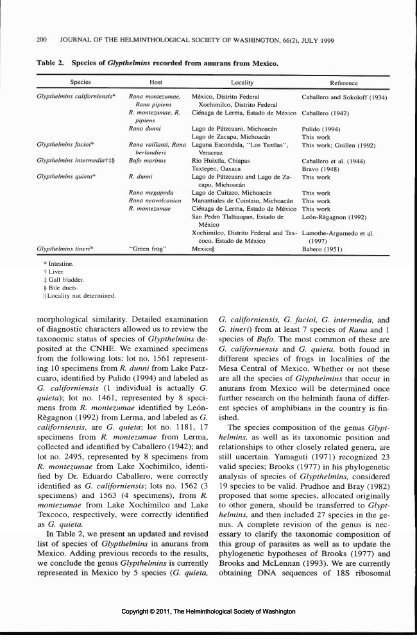The Helminthological Society of Washington - Peru State College
The Helminthological Society of Washington - Peru State College
The Helminthological Society of Washington - Peru State College
Create successful ePaper yourself
Turn your PDF publications into a flip-book with our unique Google optimized e-Paper software.
200 JOURNAL OF THE HELMINTHOLOGICAL SOCIETY OF WASHINGTON, 66(2), JULY 1999<br />
Table 2. Species <strong>of</strong> Glypthelmins recorded from anurans from Mexico.<br />
Species<br />
Host<br />
Locality<br />
Reference<br />
Glypthelmins califomiensis*<br />
Glypthelmins facial*<br />
Glypthelmins intermedia']"^<br />
Glypthelmins quieta*<br />
Glypthelmins tineri*<br />
* Intestine.<br />
t Liver.<br />
$ Gall bladder.<br />
§ Bile ducts.<br />
|| Locality not determined.<br />
Rana montezumae,<br />
Rana pipiens<br />
R. montezumae, R.<br />
pipiens<br />
Rana dunni<br />
Rana vaillanti, Rana<br />
berlandieri<br />
Bufo marinus<br />
R. dunni<br />
Rana megupoda<br />
Rana neovolcanica<br />
R. montezumae<br />
"Green frog"<br />
Mexico, Distrito Federal<br />
Xochimilco, Distrito Federal<br />
Cienaga de Lerma, Estado de Mexico<br />
Lago de Patzcuaro, Michoacan<br />
Lago de Zacapu, Michoacan<br />
Laguna Escondida, "Los Tuxtlas",<br />
Veracruz<br />
Rio Huixtla, Chiapas<br />
Tuxtepec, Oaxaca<br />
Lago de Patzcuaro and Lago de Zacapu,<br />
Michoacan<br />
Lago de Cuitzeo, Michoacan<br />
Manantiales de Cointzio, Michoacan<br />
Cienaga de Lerma, Estado de Mexico<br />
San Pedro Tlaltizapan, Estado de<br />
Mexico<br />
Xochimilco, Distrito Federal and Texcoco,<br />
Estado de Mexico<br />
Mexico||<br />
Caballero and Sokol<strong>of</strong>f ( 1 934)<br />
Caballero (1942)<br />
Pulido (1994)<br />
This work<br />
This work; Guillen (1992)<br />
Caballero et al. (1944)<br />
Bravo (1948)<br />
This work<br />
This work<br />
This work<br />
This work<br />
Leon-Regagnon ( 1 992)<br />
Lamothe-Argumedo et al.<br />
(1997)<br />
Babero ( 1 95 1 )<br />
morphological similarity. Detailed examination<br />
<strong>of</strong> diagnostic characters allowed us to review the<br />
taxonomic status <strong>of</strong> species <strong>of</strong> Glypthelmins deposited<br />
at the CNHE. We examined specimens<br />
from the following lots: lot no. 1561 representing<br />
10 specimens from R. dunni from Lake Patzcuaro,<br />
identified by Pulido (1994) and labeled as<br />
G. calif orniensis (1 individual is actually G.<br />
quieta); lot no. 1461, represented by 8 specimens<br />
from R. montezumae identified by Leon-<br />
Regagnon (1992) from Lerma, and labeled as G.<br />
californiensis, are G. quieta; lot no. 1181, 17<br />
specimens from R. montezumae from Lerma,<br />
collected and identified by Caballero (1942); and<br />
lot no. 2495, represented by 8 specimens from<br />
R. montezumae from Lake Xochimilco, identified<br />
by Dr. Eduardo Caballero, were correctly<br />
identified as G. californiensis; lots no. 1562 (3<br />
specimens) and 1563 (4 specimens), from R.<br />
montezumae from Lake Xochimilco and Lake<br />
Texcoco, respectively, were correctly identified<br />
as G. quieta.<br />
In Table 2, we present an updated and revised<br />
list <strong>of</strong> species <strong>of</strong> Glypthelmins in anurans from<br />
Mexico. Adding previous records to the results,<br />
we conclude the genus Glypthelmins is currently<br />
represented in Mexico by 5 species (G. quieta,<br />
G. calif orniensis, G. facioi, G. intermedia, and<br />
G. tineri) from at least 7 species <strong>of</strong> Rana and 1<br />
species <strong>of</strong> Bufo. <strong>The</strong> most common <strong>of</strong> these are<br />
G. californiensis and G. quieta, both found in<br />
different species <strong>of</strong> frogs in localities <strong>of</strong> the<br />
Mesa Central <strong>of</strong> Mexico. Whether or not these<br />
are all the species <strong>of</strong> Glypthelmins that occur in<br />
anurans from Mexico will be determined once<br />
further research on the helminth fauna <strong>of</strong> different<br />
species <strong>of</strong> amphibians in the country is finished.<br />
<strong>The</strong> species composition <strong>of</strong> the genus Glypthelmins,<br />
as well as its taxonomic position and<br />
relationships to other closely related genera, are<br />
still uncertain. Yamaguti (1971) recognized 23<br />
valid species; Brooks (1977) in his phylogenetic<br />
analysis <strong>of</strong> species <strong>of</strong> Glypthelmins, considered<br />
19 species to be valid. Prudhoe and Bray (1982)<br />
proposed that some species, allocated originally<br />
to other genera, should be transferred to Glypthelmins,<br />
and then included 27 species in the genus.<br />
A complete revision <strong>of</strong> the genus is necessary<br />
to clarify the taxonomic composition <strong>of</strong><br />
this group <strong>of</strong> parasites as well as to update the<br />
phylogenetic hypotheses <strong>of</strong> Brooks (1977) and<br />
Brooks and McLennan (1993). We are currently<br />
obtaining DNA sequences <strong>of</strong> 18S ribosomal<br />
Copyright © 2011, <strong>The</strong> <strong>Helminthological</strong> <strong>Society</strong> <strong>of</strong> <strong>Washington</strong>
















